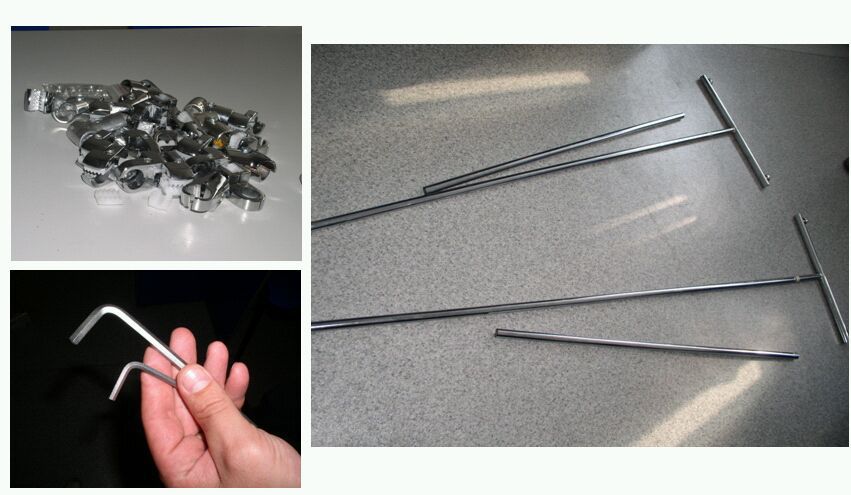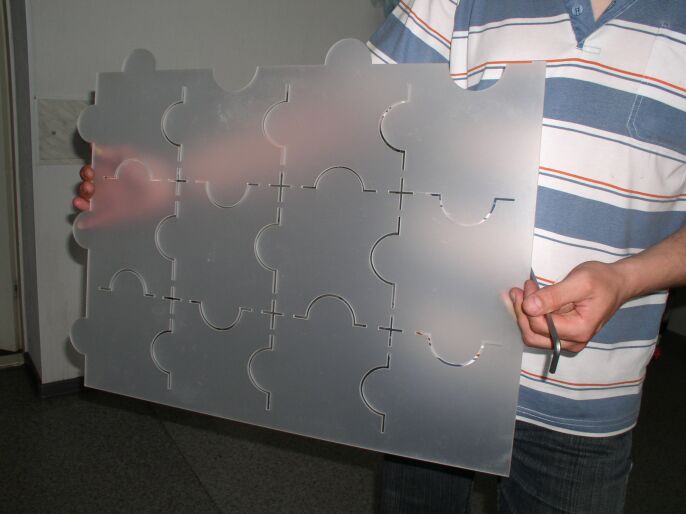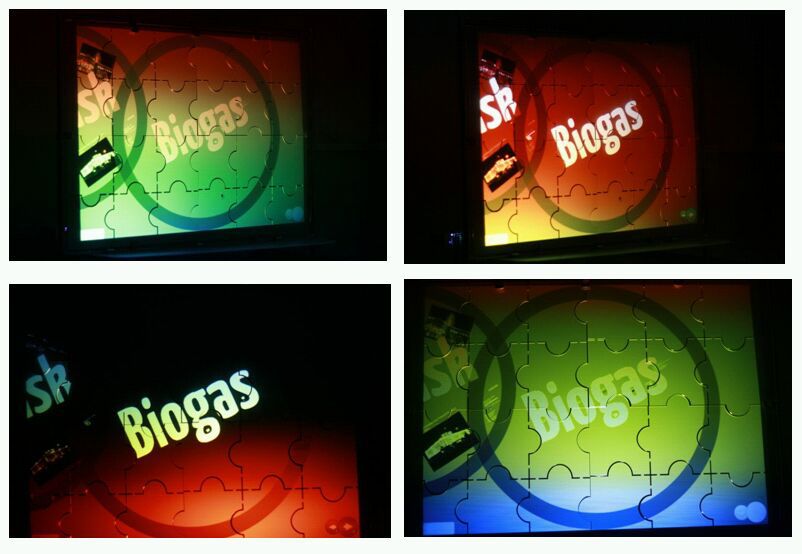DIY projection screen
Numerous participation in various exhibitions gave me the idea that it was necessary to come up with a way to constantly attract visitors to the exhibition stand in some unusual way. A certain amount of brain stress and a trip to your favorite household suggested an interesting idea. As a result, we make an unusual projection screen.
As I said in one of my previous posts - the home store is a great place for an amateur to do something interesting. So this time - we’ll buy everything we need in the department of furniture accessories
1. Corner joints 90 gr. - 4 things.
2. Connection sleeve - 2 pcs.
3. Mounts for crocodile glass - 11 pcs.
4. “T” shaped leg - 2 pcs.
5. Vertical rod (nickel-plated tube) - length 180 cm - 2 pcs.
6. Horizontal bar (nickel-plated tube) - length 120 cm - 2 pcs.
In the photo you can see all these details. The “T” shaped legs are already connected to the vertical rods by two connecting sleeves.

Also for assembly, you will need two hexagons 4 and 6 mm. It is clear that the rods are sold at three meters. In any store, you can immediately cut off the details of the required length with a hacksaw for metal. This is perhaps the only "locksmith" in this case)
Skillfully wielding hexagons, we connect the structure together and put it on its feet. It should turn out like in the photo. We lightly fix eight “crocodiles” around the perimeter, but so far we’re not tightening it much.

In order not to reconcile the length of the structure and the joints every time, apply small marks with a permanent marker. It is very comfortable.
A feature of this design is the screen itself. It is made of frosted plexiglass, in which puzzles are cut out, as shown in this photo. The screen consists of four such parts that are held in the frame by “crocodiles”.

For the manufacture of the screen used laser cutting. We assemble the structure together, combining adjacent puzzles and align so that there are no large gaps.

We tighten the “crocodiles” with a hexagon, but without much effort. Details and so perfectly held. The design also provides for a shelf for advertising materials, which is fixed to the remaining three “crocodiles”. I also recommend buying two or three crocodiles in reserve. We had a breakdown case. Burst the jaw of the Chinese "crocodile" in warm Russian hands with a strong pull)
Many have probably already guessed that the screen is used to project presentations and video from a multimedia projector. The projector is installed at the back of the screen and works in clearance. At the same time, you must specify the mirror mode of translation in the projector settings. Thus, the projector is hidden from the viewer and it seems that a thin plasma screen is working. However, this is not all. The projector constantly creates beautiful highlights, as light penetrates through the slots of puzzles. These rays fall on the walls of people passing the exhibition, on the floor, etc. and immediately cause interest and attention. At the same time, a noticeable effect extends to 2-4 meters and does not interfere with other exhibitors. We use the 3000 Lumen projector, which “attacks” the screen even in strong light, creating an excellent contrast image. In the dark, the device and the glare from the puzzles are simply bewitching. The shape of the screen in the form of puzzles acts especially positively on people. Something in them is spiritual. From childhood)
When this screen was created, we did not expect the occurrence of diffraction effects, which do not allow you to photograph the screen on a camera or take it on a professional camera. The image begins to shimmer with all the colors of the rainbow. Man does not see this. The screen “tricks” digital matrices. The diffraction effect occurs at the interface of optical media in puzzles. The photo takes pictures of the same slide from different angles to the screen. The background of the original slide is gray. It looks unusual.

The device turned out with a diagonal of 150 cm. You can make the screen larger, but even this created just a great effect at exhibitions. It got ridiculous - sometimes people asked more about the screen than about our products. The price of the whole structure is about $ 100. The projector, of course, is not included in the price) I will not bore readers with additional details and subtleties, but they still exist. The most important thing is the features and optical parameters of plexiglass. In this file (PDF 35 kB), anyone can read more about this. The file also contains a link to a plexiglass pattern for laser cutting.
Of course, I’m attaching a video . At the beginning of the video, you can see the diffraction distortion of the screen.
Have a nice day, everyone!
What do we need?
As I said in one of my previous posts - the home store is a great place for an amateur to do something interesting. So this time - we’ll buy everything we need in the department of furniture accessories
1. Corner joints 90 gr. - 4 things.
2. Connection sleeve - 2 pcs.
3. Mounts for crocodile glass - 11 pcs.
4. “T” shaped leg - 2 pcs.
5. Vertical rod (nickel-plated tube) - length 180 cm - 2 pcs.
6. Horizontal bar (nickel-plated tube) - length 120 cm - 2 pcs.
In the photo you can see all these details. The “T” shaped legs are already connected to the vertical rods by two connecting sleeves.

Also for assembly, you will need two hexagons 4 and 6 mm. It is clear that the rods are sold at three meters. In any store, you can immediately cut off the details of the required length with a hacksaw for metal. This is perhaps the only "locksmith" in this case)
Metal frame assembly
Skillfully wielding hexagons, we connect the structure together and put it on its feet. It should turn out like in the photo. We lightly fix eight “crocodiles” around the perimeter, but so far we’re not tightening it much.

In order not to reconcile the length of the structure and the joints every time, apply small marks with a permanent marker. It is very comfortable.
“Stretch” the screen
A feature of this design is the screen itself. It is made of frosted plexiglass, in which puzzles are cut out, as shown in this photo. The screen consists of four such parts that are held in the frame by “crocodiles”.

For the manufacture of the screen used laser cutting. We assemble the structure together, combining adjacent puzzles and align so that there are no large gaps.

We tighten the “crocodiles” with a hexagon, but without much effort. Details and so perfectly held. The design also provides for a shelf for advertising materials, which is fixed to the remaining three “crocodiles”. I also recommend buying two or three crocodiles in reserve. We had a breakdown case. Burst the jaw of the Chinese "crocodile" in warm Russian hands with a strong pull)
Why puzzles and how does it all work?
Many have probably already guessed that the screen is used to project presentations and video from a multimedia projector. The projector is installed at the back of the screen and works in clearance. At the same time, you must specify the mirror mode of translation in the projector settings. Thus, the projector is hidden from the viewer and it seems that a thin plasma screen is working. However, this is not all. The projector constantly creates beautiful highlights, as light penetrates through the slots of puzzles. These rays fall on the walls of people passing the exhibition, on the floor, etc. and immediately cause interest and attention. At the same time, a noticeable effect extends to 2-4 meters and does not interfere with other exhibitors. We use the 3000 Lumen projector, which “attacks” the screen even in strong light, creating an excellent contrast image. In the dark, the device and the glare from the puzzles are simply bewitching. The shape of the screen in the form of puzzles acts especially positively on people. Something in them is spiritual. From childhood)
Well, what does physics have to do with it?
When this screen was created, we did not expect the occurrence of diffraction effects, which do not allow you to photograph the screen on a camera or take it on a professional camera. The image begins to shimmer with all the colors of the rainbow. Man does not see this. The screen “tricks” digital matrices. The diffraction effect occurs at the interface of optical media in puzzles. The photo takes pictures of the same slide from different angles to the screen. The background of the original slide is gray. It looks unusual.

To summarize
The device turned out with a diagonal of 150 cm. You can make the screen larger, but even this created just a great effect at exhibitions. It got ridiculous - sometimes people asked more about the screen than about our products. The price of the whole structure is about $ 100. The projector, of course, is not included in the price) I will not bore readers with additional details and subtleties, but they still exist. The most important thing is the features and optical parameters of plexiglass. In this file (PDF 35 kB), anyone can read more about this. The file also contains a link to a plexiglass pattern for laser cutting.
Of course, I’m attaching a video . At the beginning of the video, you can see the diffraction distortion of the screen.
Have a nice day, everyone!
